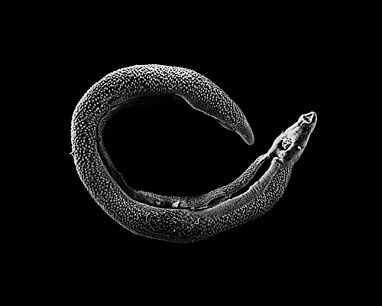
👀 Be Naturally Aware from the Field of Master Mind Health (MMH) 🧬
Shared from the research of: Joseph Mercado 🧑💻
Article Author: National Institutes of Health (NIH) 🌍
To: Health Lover 💚
Blog Post #1192 📌
Re: Compounds That Block Parasitic Worms 🪱
Date and Time: Sunday, January 30, 2022 at 8:25 p.m. ⏰
Dear Health Lover,
Scientists have identified a molecule that holds promise for treating schistosomiasis, a disease caused by a parasitic worm that afflicts more than 200 million people worldwide.
The compound can destroy all 3 major species of Schistosoma worms that infect humans. It also blocked all stages of the worm’s development in infected mice.
Schistosomiasis, also known as bilharzia or snail fever, primarily affects people living in the tropical regions of developing countries.
It kills nearly 300,000 people each year and seriously disables about 20 million, causing severe anemia, diarrhea, internal bleeding or organ damage.
Microscopic Schistosoma parasites infect people who are wading, swimming or bathing in fresh water inhabited by infected snails.
The parasites bore through human skin and then migrate into the blood vessels that supply the intestinal and urinary systems.
After the worms mature and reproduce, their eggs are eliminated in human urine and feces.
If human waste contaminated by worm eggs finds its way into fresh water, the cycle begins again.
Today, only one drug, praziquantel, is widely used to treat schistosomiasis.
It works primarily by killing the adult stages of the parasite in the human body.
But public health experts worry that the parasite will eventually develop resistance to praziquantel and the drug will lose its effectiveness.
Researchers from Illinois State University and NIH’s Chemical Genomics Center have been working to find new avenues for treating schistosomiasis.
Their research is supported by NIH’s National Institute of Allergy and Infectious Diseases (NIAID) and the NIH Roadmap for Medical Research.
As reported in the March 16, 2008, advance online edition of Nature Medicine, the scientists used an advanced robotic system to screen thousands of molecules that might help to block key molecular pathways that keep the parasite alive.
One of the identified molecules, known as furoxan, inhibited an enzyme vital to survival of the Schistosoma worm. Furoxan is a type of molecule called an oxadiazole. It appears to both inhibit a key parasite enzyme and to trigger a lethal oxidative process in the worm.
The researchers showed that furoxan killed worms in all their developmental stages, from larvae to adult. When given to Schistosoma-infected mice, furoxan was well-tolerated. It effectively reduced the number of worms and prevented much of the liver damage that can occur with infection.
Oxadiazole molecules like furoxan represent a promising new approach for treating schistosomiasis and possibly other infectious diseases, according to Dr. David L. Williams, the study’s lead researcher and a professor of biology at Illinois State University. “Still, much remains to be done,” he says.
“Our ultimate goal is to see our basic biological findings translated into help for people with schistosomiasis.”
Content Source: NIH 🌎

 Email Us a Message
Email Us a Message 

Please send us a personal message below and we will serve you momentarily.
We appreciate you visiting the MMU Global Research Directory
For more blog posts, videos, articles, and to generate more knowledge, please feel free and…






 Fly Over to the MMU Facebook Page with Hoot
Fly Over to the MMU Facebook Page with Hoot
 Visit the MMU Facebook Group Today
Visit the MMU Facebook Group Today